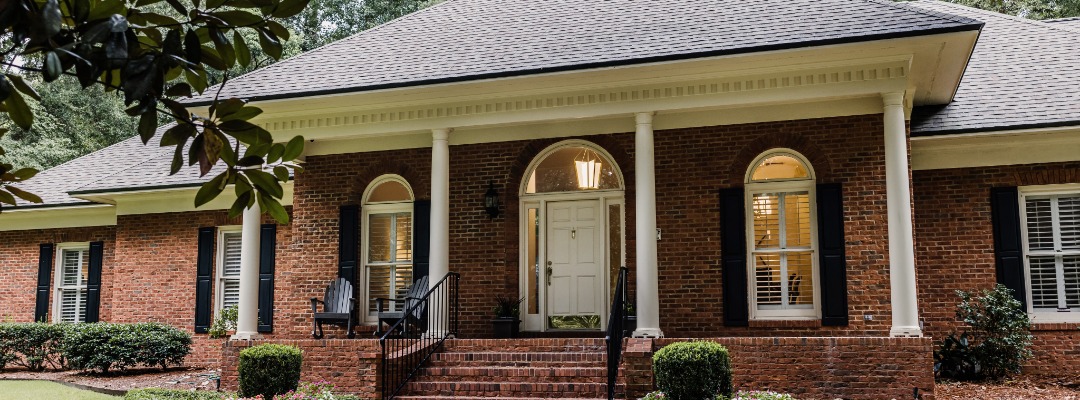How to Choose Round or Square Columns
Porch columns not only serve as support for the roof and the structure of the porch, but also as a visual anchor for the overall look of your home. Whether you want to add a grand architectural feature to the outside of your home or replace old columns, you'll need to consider what shape you want them to be.
The most important thing to keep in mind is that structural round and square porch columns are both designed to carry the weight of your porch roof. Choosing round porch columns rather than square isn't going to matter from a load-bearing perspective.

Square Columns: Modern Appeal
Square porch columns are popular for many homeowners because they have a modern look that fits various architectural styles. Square columns became popular in the 20th Century during the housing boom that kicked in after World War II. Two of the most popular styles were bungalow and craftsman-style homes, and both were ideally suited to square columns.
One of the advantages of square wood columns was that they were easier to manufacture – which is a big benefit when you're building that many homes. The square column design remains a staple for home builders to this day.
Perhaps the only disadvantage to the square column design is its sharp edges, which could pose a hazard for small children and pets. Aside from this, there's no real downside to choosing square vs. round porch columns for your property.

Round Columns: Statement Makers
Let's face it, when you pull up a long driveway to a home that boasts multiple round columns, you may expect a well-heeled butler to answer the doorbell. Round columns make a bold statement, giving a home a sense of elegance and wealth. They have graced stately manors for centuries, providing the owners an air of having arrived.
Round porch columns have a long, storied history that began with Ancient Greeks and Romans, who installed round columns on temples, libraries and civic buildings. There are five classic styles of round column design:
- Doric: The earliest Greek column is the doric. This is a basic circular column design that's often plain but sometimes includes a fluted accent. Doric columns rest right on the pavement without a base.
- Ionic: More slender than its predecessor, the ionic column is round with a base and is typically fluted. Some ionic columns have a volute, which is a scroll-like ornament that's positioned on the cap of the column.
- Corinthian: These circular columns are tall and thin. Corinthian columns feature a decorative base and have volutes and foliage on the top.
- Tuscan: A Roman version of the Doric column that's plain without fluting.
- Composite: The Romans combined the Greek ionic and Corinthian styles to develop the composite column, which has an ornate top.
Note: The modern definition of composite columns relates to the structure of the column rather than the design. These days, when someone talks about composite columns, they're referring to columns made with a combination of structural concrete and structural steel.
Anatomy of Round & Square Column Design
There are three main parts to any column, whether it has a round or square column design:
- Base: The bottom portion of the column that sits on the ground.
- Shaft: The middle part of the column.
- Capital: The top of the column, which bears the load of the roof.
The Stuff Columns Are Made Of
The material used to make your porch column may be any one of the following:
- Fiberglass: Permacast Plus™ Columns
- Fiberglass: PermaLite® Columns
- Aluminum
- Wood
In addition, you may opt for PVC column wraps. These easy-to-install square or round column wraps encase a new or existing post with a covering that's impervious to moisture and insects.
Frequently Asked Questions About Square vs. Round Columns
Following are answers to some common questions about square vs. round columns. If at any point you want to know more, HB&G is here to answer any questions you may have.
What's the Difference Between a Post and a Column?
Posts are smaller in diameter than columns. They are typically 4", 5" or 6", while columns are 10" around.
How Can I Tell if My Columns Are Load-Bearing or Decorative?
There are four ways to check and see if your column is load-bearing:
- Review the building plans.
- Look for seams.
- Pull the capital away from the ceiling.
- Look at the column's material.
Are There Column Wraps for Both Round and Square Columns?
Yes, you can get round or square column wraps. This is a quick and easy way to update an existing square or round column.
Square vs. Round Columns – the Choice Is All Yours at HB&G
Square and round porch columns each have their own advantages. By considering your personal style, architectural design and practical needs, you can make an informed decision and choose the porch columns that will best enhance the look and function of your residential or commercial property. When you've decided on square vs. round columns, HB&G can help you get the wood, metal or fiberglass columns you need to get the job done. Find yours today!
Shop HB&G Columns
